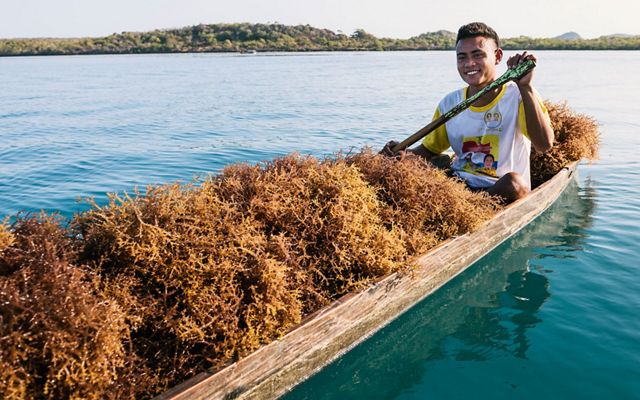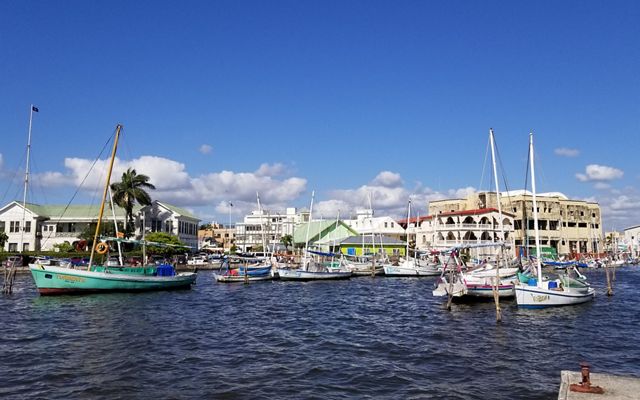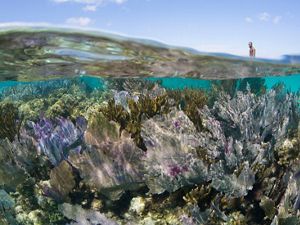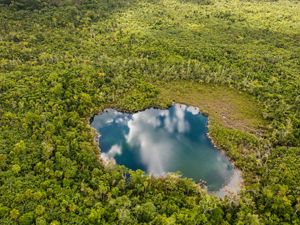How Belize is Transforming the Caribbean
Belize just committed to protecting 30 percent of its ocean territory, with the support of the largest debt conversion for ocean conservation to date.
By many accounts, Belize is a conservation success story, and a role model when it comes to climate and biodiversity action. While the country is only about the size of the U.S. state of New Jersey, it is dense with flora and fauna unique to this part of the Caribbean and Central America, and much of that treasure lies along its cerulean coast. But the nation’s natural assets are more than just a point of pride: they represent a large and vital part of its economy.
The Belize Barrier Reef System features three of four coral atolls in the Atlantic, lush mangrove forests, numerous offshore islands, and one of the most extensive seagrass areas in the Caribbean. It hosts 77 species listed as threatened by the IUCN, including a sizeable population of West Indian Manatees.
Now, Belize has reaffirmed its environmental leadership by becoming the first country in the Americas to finalize a debt conversion for ocean conservation—and one that represents an impact investment for marine protection that’s unprecedented in scale. This commitment will enable Belize to restructure approximately US$550 million of external commercial debt—an amount that represents 30 percent of the country’s GDP—and reduce the national debt by 12 percent.

The conservation significance is similarly impressive—Belize’s investment will drive US$180 million back into the conservation of its marine ecosystems over the next two decades. The country has also committed to protecting 30 percent of its ocean territory, which it will achieve using a participatory, stakeholder-driven marine spatial planning process. Other significant conservation measures on the agenda include developing governance frameworks for domestic and high-seas fisheries, and implementing a regulatory framework for coastal blue carbon projects. And all these actions have the potential to boost local economies and protect a resource that’s invaluable for Belizeans—half of whom live along the coast.
Belize’s new commitments are especially notable in this second year of a critical decade for nature, with countries coming together for UN meetings to prevent runaway species loss that threatens all life on Earth—even as much of the world is still reeling from the human and economic tolls of COVID-19. While the Central American tourist destination has suffered outsized financial impacts, it is positioning itself to be among the first countries in the Americas to achieve 30 percent ocean protection by 2030.
The value of nature in Belize
For those familiar with Belizeans’ close relationship with nature, such an effort may not come as a surprise. The 139,000 people who live on the coast rely on healthy marine ecosystems for food and jobs, with commercial fisheries alone contributing US$30 million to Belize’s annual GDP. Another 209,000 visitors are drawn to the region annually, where they spend US$81 million. Tourism—an estimated 25 percent of which is reef based—generates 41 percent of the national income.
-
30%
Belize has committed to protecting 10,113 square kilometers, or 30 percent, of its ocean areas
-
77
species listed as threatened by the IUCN live in the Belize Reef System
-
209K
tourists visit the Belize region annually
-
41%
Tourism represents 41 percent of the national income
UNESCO designated the Belize Barrier Reef Reserve System a World Heritage site in 1996. But by 2009, its array of coral reefs, mangroves, seagrasses, and other globally significant habitats landed on UNESCO’s List in Danger, threatened by offshore oil exploration and unsustainable development projects—not to mention intensifying climate impacts like stronger storms, flooding, coastal erosion and coral bleaching.
Those threats make Belize’s efforts to turn the situation around particularly impressive. In recent years, the government has placed an indefinite moratorium on offshore oil exploration, banned the use of trawlers in Belizean waters, and worked to curb overfishing. In 2018, UNESCO removed Belize’s Barrier Reef—the second longest worldwide and one-third of the 900-kilometer Mesoamerican Reef—from the endangered list.
The “nature funding gap” in Belize
Still, the nation must confront a marine conservation funding gap of approximately US$5 million a year to enforce existing protected areas and new conservation commitments. Without this innovative sustainable finance project, Belize’s natural wealth—along with the blue economy it supports—would remain in danger.
Due to a lack of financial and human resources to implement and manage existing marine protections, Belize’s coastal and marine resources face intense pressure from overfishing and unchecked coastal development. Development on privately owned or leased land often involves destroying mangrove habitat, which stores hundreds to thousands of years of carbon from the biomass and soils. A loss of mangroves would also expose communities to higher storm risks, and harm critical habitats along with the species that rely upon them—including whale sharks, angelfish, parrotfish, the critically endangered Hawksbill Turtle, and dozens of corals.
Funding ocean conservation and climate change adaptation activities is difficult for most countries, but the challenge is particularly acute for those that are highly dependent on vulnerable marine resources. These governments often experience high debt burdens, further limiting their ability to invest such activities—and thus perpetuating their vulnerability to natural disasters and economic downturns. This has been especially true for Belize in the wake of COVID-19—and that’s where the blue bond can help.


The Americas' first debt conversion for marine conservation
At the heart of the blue bonds project is a basic deal. In this case, Belize has committed to protecting up to 30 percent (10,113 square kilometers) of its ocean areas, including coral reefs, seagrass beds, mangroves and other important marine habitats. To support this commitment, The Nature Conservancy (TNC)—led by local staff in Belize and supported by NatureVest, TNC's impact investing team—has helped restructure approximately US$550 million of the nation’s external debt, leading to a lower outstanding debt balance and a longer repayment period.
With the resulting savings, the government can then invest in a national, independent conservation fund that will provide millions of dollars in grants to government agencies and conservation partners working in Belize’s ocean and coastal areas, including new protected areas. The result is 20 years of direct funding for conservation—around US$4.2 million annually—as well as seed funding of an endowment estimated to grow to US$92 million over 20 years to sustain ongoing funding after the restructured debt has been repaid.
This project emerged when the Belizean government requested TNC’s technical assistance with refinancing its external commercial debt in order to generate funding for conservation, including the development and implementation of a marine spatial plan (MSP), to balance the needs of people and nature. Marine spatial planning offers governments, local communities and marine industries with transparent, equitable and participatory processes to navigate challenges, develop effective and durable solutions, and plan for a sustainable future.
Through rigorous scientific processes, TNC identified Belize as a place where debt strategies could create significant long-term benefits. In addition to supporting the financial transaction, the organization will also work with local partners to identify activities that combine conservation and sustainable economic activities, such as restoring reefs for tourism and improving fisheries management—ensuring that the project supports real and durable ocean conservation, as opposed to protection efforts “in name only.”
Quote

We only have one ocean: good and bad actions ripple far and wide, with global consequences for the biodiversity and climate we all need.
Ocean conservation worldwide
In 2016, the Republic of Seychelles became the first to show how countries could unlock sustainable funding at scale by transforming their debt into a new cash flow for marine conservation. In partnership with TNC, the island nation used a similar transaction to generate up to US$430,000 a year for marine conservation. As of 2020, Seychelles has protected 410,000 square kilometers of ocean—an area twice the size of Great Britain—or more than 30 percent of its ocean territory.
Modeled after the Seychelles transaction, but at a financial scale more than 15 times larger, Belize is leading not only in the Americas, but on the world stage. Ocean conservation remains the least addressed of the UN’s sustainable development goals (SDGs), despite that the ocean contributes an estimated US$3 trillion to the global GDP each year.
That must change if we are to achieve the rest of the SDGs and set the world on a more sustainable path, because we only have one ocean: good and bad actions ripple far and wide, with global consequences for the biodiversity and climate we all need.
Belize is showing that with smart governance, countries can afford to protect the ocean while providing for the health and wealth of their people. As global leaders prepare to make new commitments for nature, it is up to the rest of the world to decide whether this ripple can help turn the tide on marine conservation.
Many supporters made this project possible through years of effort, including: Becht Family Charitable Trust, Oceans 5, TED Audacious Project, Jeff and Laurie Ubben, and the Wyss Foundation.
Global Insights
Check out our latest thinking and real-world solutions to some of the most complex challenges facing people and the planet today.



